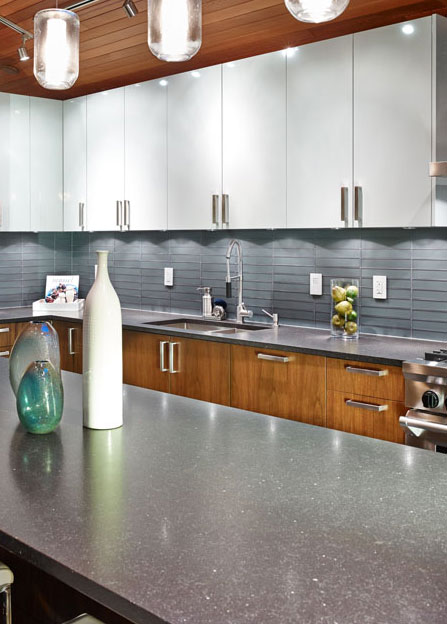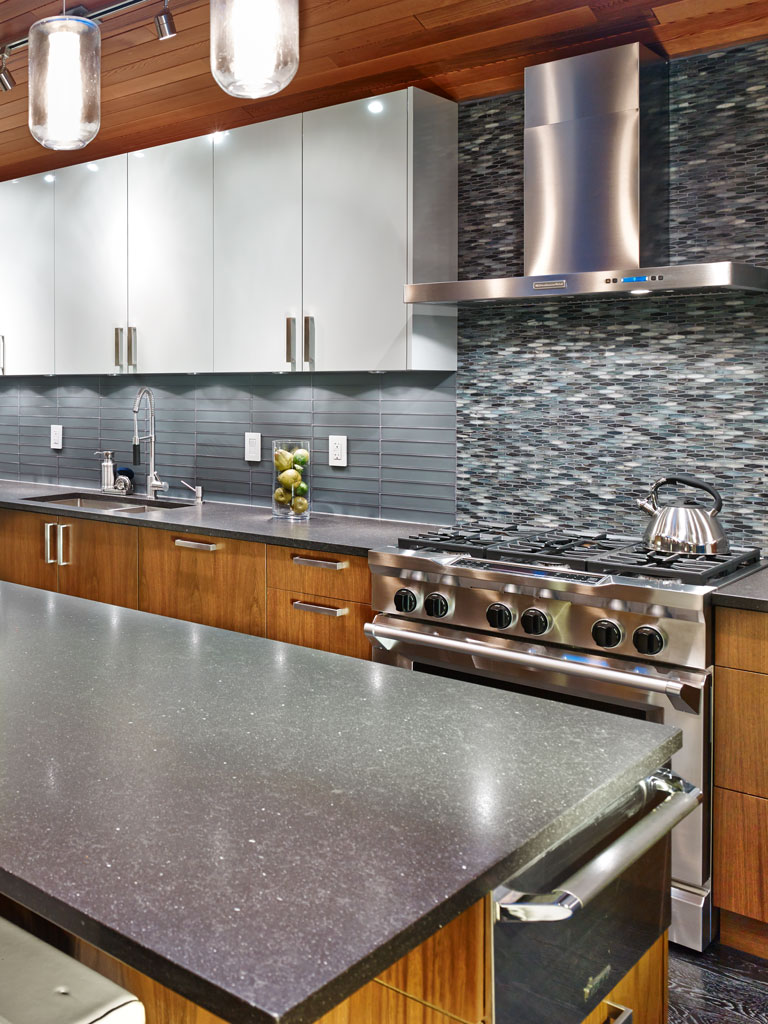Getting More Value From Your Images with Cropping
We're shooting most of our higher-end projects using medium format digital these days. While it takes just a little bit longer, it has all sorts of advantages over digital SLRs, including better, more accurate perspective and colour (which our architect and interior design clients particularly appreciate), and images that have ultimate detail and resolution. While very few of you are printing our images at the poster or billboard sizes where the extra resolution really shines, having the extra resolution available gives you a lot of flexibility in how you crop your architectural photographs, and that translates into making our images much more versatile and valuable for you.
Cropping? What's that?
Let's back up for a moment. Crop is a fancy way of saying 'cut down'--in this case, an image from one size to a (usually) smaller size. There are a bunch of reasons to do this, including removing distracting elements, 'zooming in' on a particular feature, or making a photo fit a different format than how it was originally shot. In Real Life™, you've done this every time you've put a picture into a frame that's a lot smaller. Almost every image editing application (even the built-in stuff on your smartphone!) has a tool that lets you do this to digital images. For instance, let's take an image from a recent shoot for TQ Construction, and imagine a countertop supplier wanted to use the image on the cover of their next brochure. Once they licensed the image, they'd open it up in an image editing tool like Photoshop:
...and crop it. When you crop, Photoshop helpfully gives you a rectangle that shows the area we want, and greys out what we don't. We can move the rectangle around until we've selected what we want, and then...boom! We're cropped.
 Here we have the final version: we've kept the part of the image we wanted, and chucked the parts of the image we didn't. Now we're really showing the countertop, which is what the countertop supplier would likely want to show off.
Here we have the final version: we've kept the part of the image we wanted, and chucked the parts of the image we didn't. Now we're really showing the countertop, which is what the countertop supplier would likely want to show off.
Image size: underpromising and overdelivering
When you're going to use an image, your printer or graphic artist, or the folks who run the design award you're submitting for, will tell you that they want an image of a particular size. They usually tell you something like a "1024x768 image", or "enough for an 8x10 at 300DPI", "6 megapixels", or "to fill an HD monitor at 1080p". These are four different ways of specifying an image size. Let's look at them for a moment:
- 1024x768 is a pixel dimension. They want an image that's 1024 pixels wide by 768 pixels tall (or vice versa); this is a common size for website, real estate MLS, and PowerPoint presentation usage.
- 8" x 10" at 300DPI is a size and resolution. That's common in images destined for print (whether it's a magazine or your local photo print shop); it means that they want an image that can print at 8"x10" at 300 dots (i.e. pixels) per inch. Whip out your calculator, and...they're wanting an image that's 2400 pixels by 3000 pixels. (Those of you with background in print graphic arts will know that I should have said 'PPI' for this, but 'DPI' is more commonly used. Yeah, it pains me too.)
- 6 megapixels means they want an image where the horizontal * vertical pixel counts multiplied together is 6 million. Camera sensor resolutions are in megapixels, and if you get a request for something in megapixels, it usually means that they don't care about the actual dimensions as long as the resolution of the image works out to 6MP. This means that a 2000x3000 image is good, but so is a 4687x1280 image (which would be a wide panorama). When photographers quote an image size, they often specify it in megapixels because it gives us room to compose whatever size is going to work best for your application. In most cases, we deliver 20 mexapixel images (as of this writing) minimum, and often larger. More on that in a bit.
- fill an HD monitor at 1080p means that they want an image for video/presentation use on an HD display. Like the first one, this one has a specific pixel dimension: 1080p, by international standard, means 1920x1080.
So, numbers and letters aside, if we lay some of this out graphically, we get:  That little box in the lower left is 1024x768. Next up is an 8x10 print at 300dpi, which is pretty common in magazine and awards work. The green box is a 20 megapixel full-resolution image, and the big blue box is medium format digital, which is what we often deliver. You should now be realizing that, in the space of a single medium format digital image, you have a LOT of possible web images if you crop, and, strictly speaking, the resolution of over 4 8x10 prints at 300DPI.
That little box in the lower left is 1024x768. Next up is an 8x10 print at 300dpi, which is pretty common in magazine and awards work. The green box is a 20 megapixel full-resolution image, and the big blue box is medium format digital, which is what we often deliver. You should now be realizing that, in the space of a single medium format digital image, you have a LOT of possible web images if you crop, and, strictly speaking, the resolution of over 4 8x10 prints at 300DPI.
And now: fun with cropping!
When you crop, you throw pixels away (i.e. you lose image resolution). This might sound like a minor calamity if you (like us) dislike wasting things, but it actually works out to your advantage because the images you receive from us are so much higher resolution than you usually need. We gave you the whole enchilada, but you don't need to eat it all in one sitting! While you can use the full resolution image, or resize it down to whatever size you need, you can also crop down from it and get all sorts of other possible photos that will work for various uses. This means that when you pay for a single full-resolution image, what you're often really getting is a lot of possible images inside the image you paid for if you choose to use them. The smaller the image you need, the more flexibility you have. Let's pop out a couple of 8x10 crops from our example kitchen:
We've reduced them for Web use, but we could easily take the originals and print them at 8x10, or submit them as separate images for an awards program that required 8x10 300DPI images. There are many other crops possible--it's limited only by your imagination. The original image is horizontal ('landscape') orientation, and our two sample crops are horizontal, but we don't have to be limited that way. Taking a vertical crop on a horizontal image can be really effective (or vice versa):  or this:
or this:  Magazine covers often like a vertical crop with a bit of 'room to breathe' for the title and other text. Either crop would work fine for this purpose, as our fictional interior design magazine demonstrates:
Magazine covers often like a vertical crop with a bit of 'room to breathe' for the title and other text. Either crop would work fine for this purpose, as our fictional interior design magazine demonstrates: 
Down to the details
Cropping makes it easy for you to pull out a good detail shot from a larger image. Let's say you wanted a detail of the kitchen backsplash, which we didn't specifically shoot on the day. Since we're on the Web, we can easily pull a 1024x768 image out of the single image we've been working with and just show the backsplash:  And there we have a nice clean detail, suitable for Web work or a brochure inset.
And there we have a nice clean detail, suitable for Web work or a brochure inset.
Ask and ye shall receive
When we provide you with a set of images at full resolution, we often provide you with a set of "web and social" sized images, and a set of "full resolution" images, and a few other sizes (particularly if we're doing Georgie Awards photography or other awards programs that have specific requirements). Most of you are probably in the habit of uploading your web and social images to your web site or Houzz, submitting the awards images, and ignoring the full resolution images. If we've inspired you to do things with the full-resolution images, please let us know, and we'll give you the full resolution images in TIF format rather than JPEG. TIF is uncompressed, which means you'll be getting full detail. We'll do this for you free on request; the only cost to you is a larger download.



